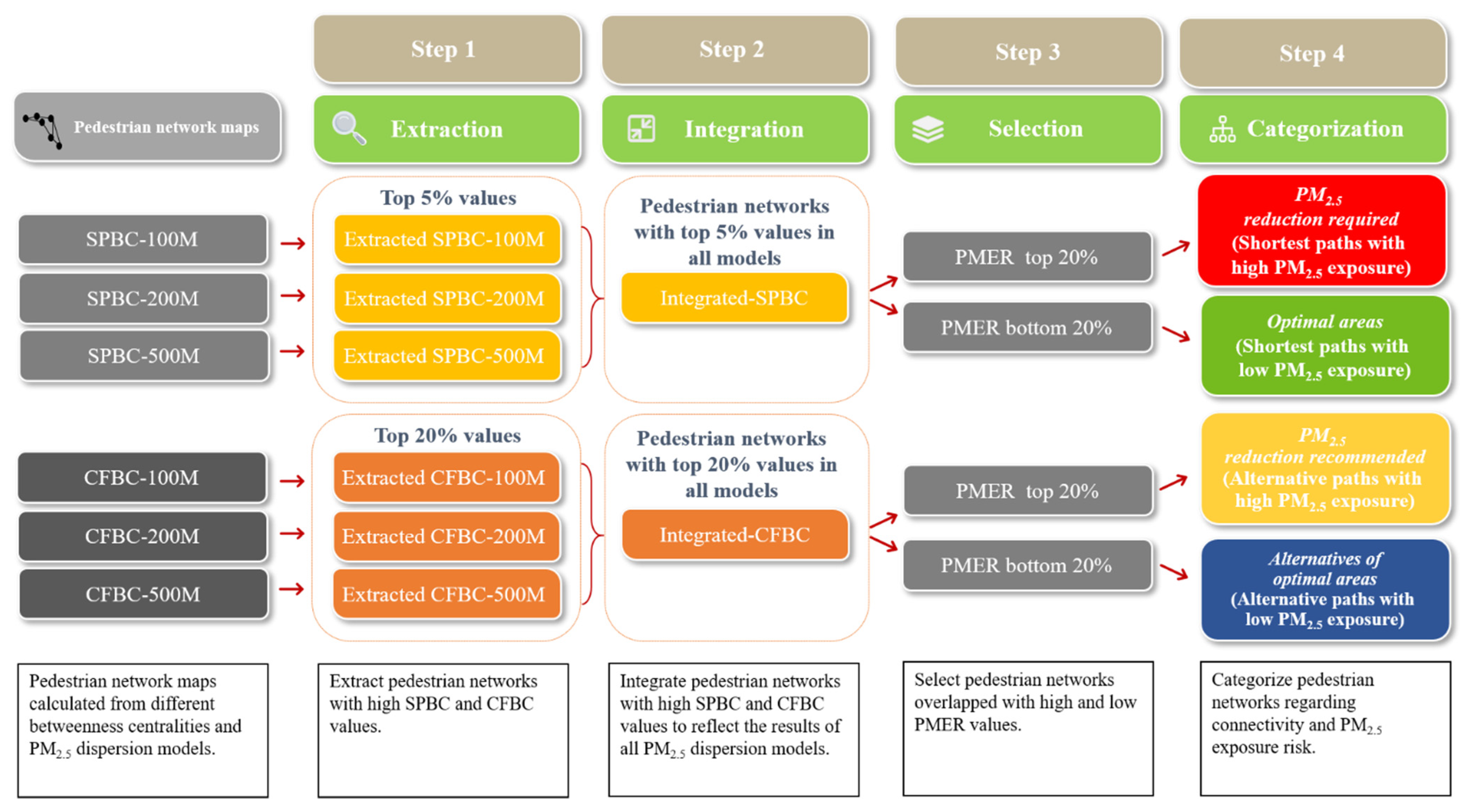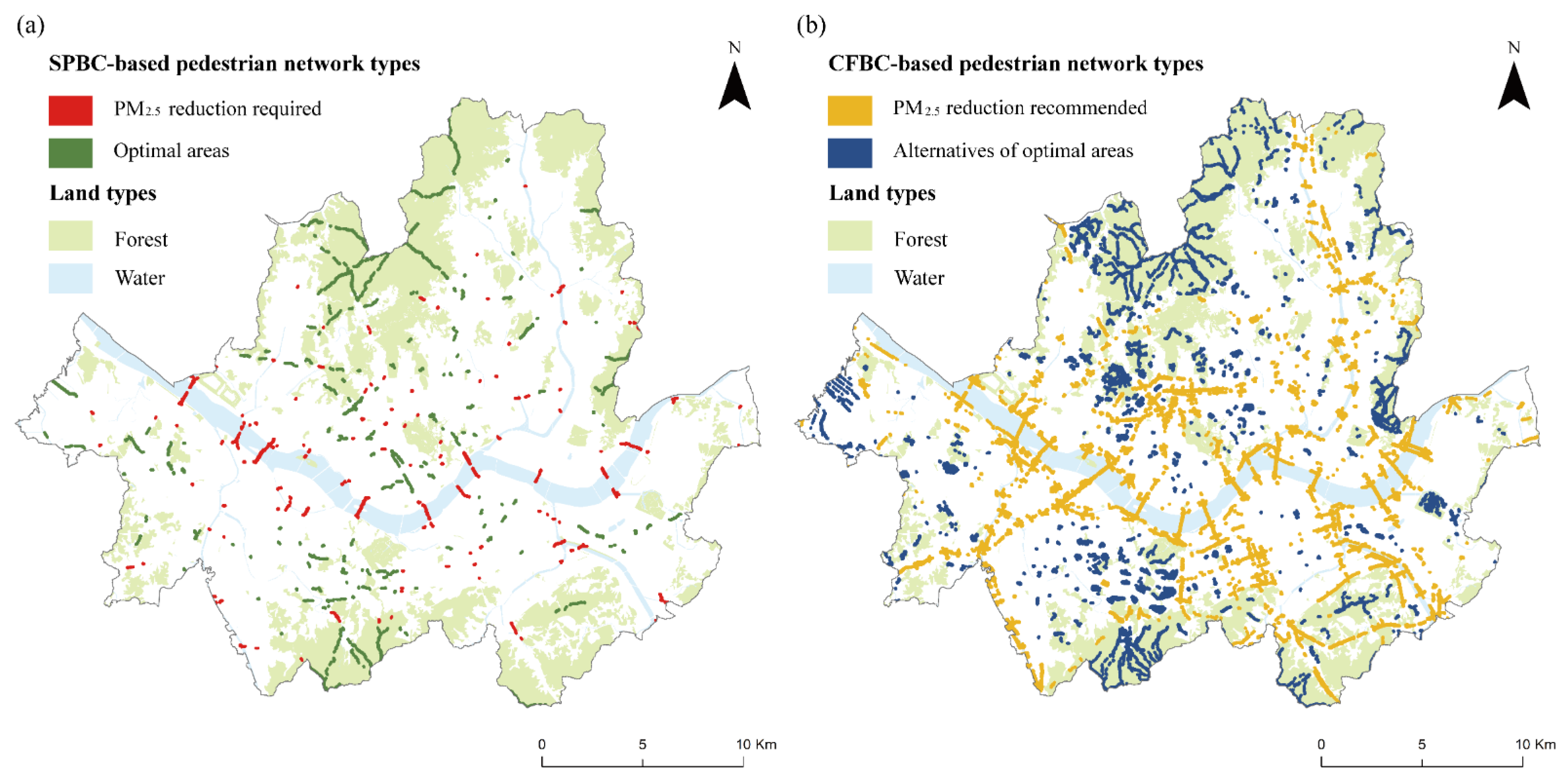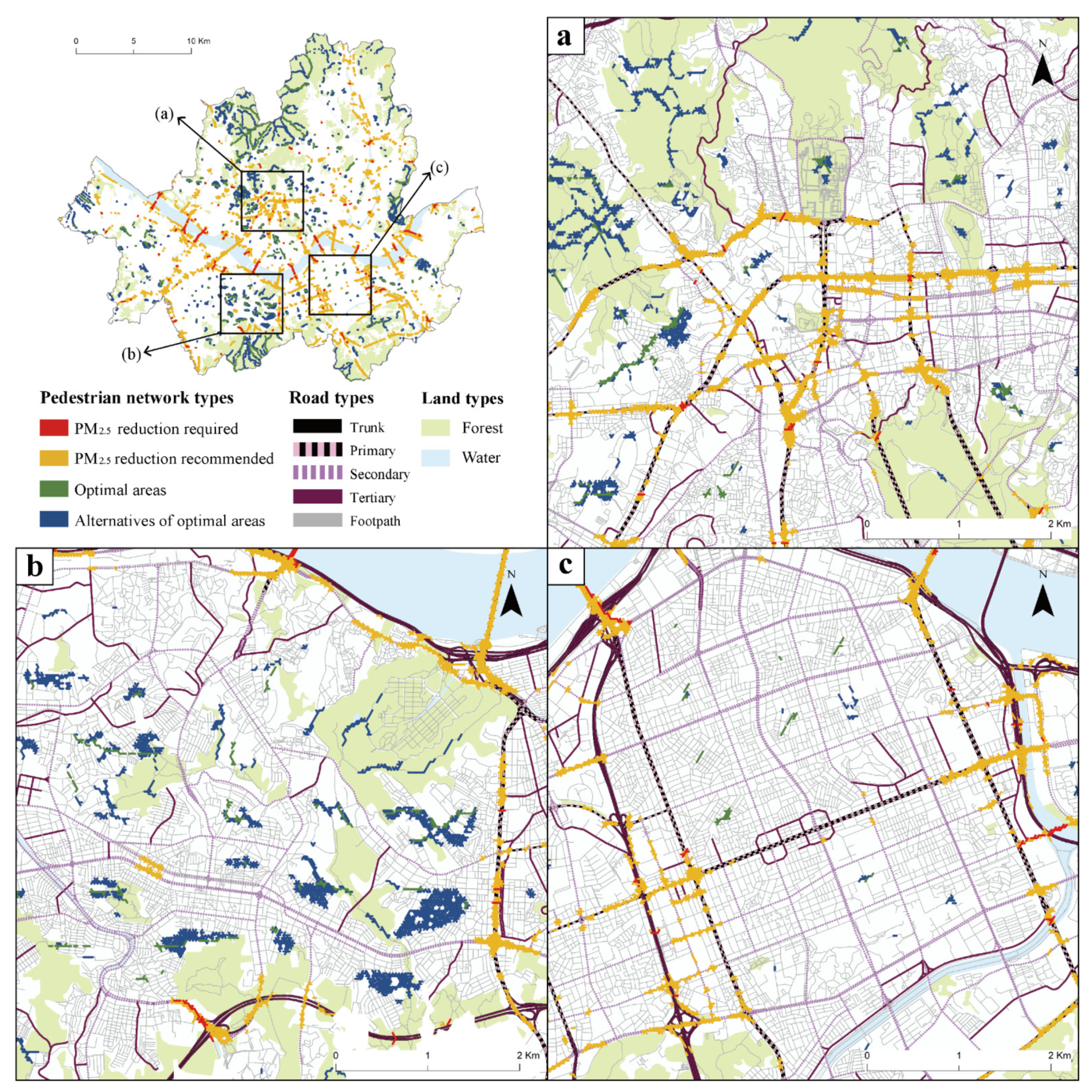A Network-Based Approach for Reducing Pedestrian Exposure to PM2.5 Induced by Road Traffic in Seoul
Abstract
:1. Introduction
2. Materials and Methods
2.1. Study Area
2.2. Data Collection and Analysis
2.2.1. PM2.5, Roadway, and Walkway Data
2.2.2. PM2.5 Effects of Roadway to Walkways
2.3. Partial Correlation Analysis
2.4. Pedestrian Network Analysis
3. Results
3.1. Partial Correlation Analysis
3.2. Pedestrian Network Analysis
4. Discussion
4.1. Contributions of Road Traffic to PM2.5 Concentrations by Season and Model
4.2. Inconsistent Relationship between Effects of Traffic Volume and Centrality
4.3. Interpretation of Centrality-Based Pedestrian Networks
4.4. Applications of Categorized Pedestrian Networks
5. Conclusions
Supplementary Materials
Author Contributions
Funding
Data Availability Statement
Acknowledgments
Conflicts of Interest
References
- Frank, L.D.; Sallis, J.F.; Saelens, B.E.; Leary, L.; Cain, L.; Conway, T.L.; Hess, P.M. The development of a walkability index: Application to the neighborhood quality of life study. Br. J. Sports Med. 2010, 44, 924–933. [Google Scholar] [CrossRef]
- Ali, M.U.; Liu, G.; Yousaf, B.; Ullah, H.; Abbas, Q.; Munir, M.A.M. A systematic review on global pollution status of particulate matter-associated potential toxic elements and health perspectives in urban environment. Environ. Geochem. Health 2019, 41, 1131–1162. [Google Scholar] [CrossRef] [PubMed]
- Kim, K.H.; Kabir, E.; Kabir, S. A review on the human health impact of airborne particulate matter. Environ. Int. 2015, 74, 136–143. [Google Scholar] [CrossRef]
- Tsang, H.; Kwok, R.; Miguel, A.H. Pedestrian exposure to ultrafine particles in Hong Kong under heavy traffic conditions. Aerosol Air Qual. Res. 2008, 8, 19–27. [Google Scholar] [CrossRef]
- Van Cauwenberg, J.; Van Holle, V.; De Bourdeaudhuij, I.; Van Dyck, D.; Deforche, B. Neighborhood walkability and health outcomes among older adults: The mediating role of physical activity. Health Place 2016, 37, 16–25. [Google Scholar] [CrossRef]
- Moreno, T.; Reche, C.; Rivas, I.; Minguillón, M.C.; Martins, V.; Vargas, C.; Buonanno, G.; Parga, J.; Pandolfi, M.; Brines, M.; et al. Urban air quality comparison for bus, tram, subway and pedestrian commutes in Barcelona. Environ. Res. 2015, 142, 495–510. [Google Scholar] [CrossRef] [PubMed]
- Atkinson, R.W.; Fuller, G.W.; Anderson, H.R.; Harrison, R.M.; Armstrong, B. Urban ambient particle metrics and health: A time-series analysis. Epidemiology 2010, 21, 501–511. [Google Scholar] [CrossRef] [PubMed]
- Cheung, K.; Daher, N.; Kam, W.; Shafer, M.M.; Ning, Z.; Schauer, J.J.; Sioutas, C. Spatial and temporal variation of chemical composition and mass closure of ambient coarse particulate matter (PM10-2.5) in the Los Angeles area. Atmos. Environ. 2011, 45, 2651–2662. [Google Scholar] [CrossRef]
- Kinney, P.L.; Gichuru, M.G.; Volavka-Close, N.; Ngo, N.; Ndiba, P.K.; Law, A.; Gachanja, A.; Gaita, S.M.; Chillrud, S.N.; Sclar, E. Traffic impacts on PM2.5 air quality in Nairobi, Kenya. Environ. Sci. Policy 2011, 95, 1–191. [Google Scholar] [CrossRef] [Green Version]
- Kumar, P.; Patton, A.P.; Durant, J.L.; Frey, H.C. A review of factors impacting exposure to PM2.5, ultrafine particles and black carbon in Asian transport microenvironments. Atmos. Environ. 2018, 187, 301–316. [Google Scholar] [CrossRef]
- Kaur, S.; Clark, R.D.R.; Walsh, P.T.; Arnold, S.J.; Colvile, R.N.; Nieuwenhuijsen, M.J. Exposure visualisation of ultrafine particle counts in a transport microenvironment. Atmos. Environ. 2006, 40, 386–398. [Google Scholar] [CrossRef]
- O’Donoghue, R.T.; Gill, L.W.; McKevitt, R.J.; Broderick, B. Exposure to hydrocarbon concentrations while commuting or exercising in Dublin. Environ. Int. 2007, 33, 1–8. [Google Scholar] [CrossRef] [PubMed]
- Qiu, Z.; Lv, H.; Zhang, F.; Wang, W.; Hao, Y. Pedestrian exposure to PM2.5, BC and UFP of adults and teens: A case study in Xi’an, China. Sustain. Cities Soc. 2019, 51, 101774. [Google Scholar] [CrossRef]
- Davies, G.; Whyatt, J.D. A network-based approach for estimating pedestrian journey-time exposure to air pollution. Sci. Total Environ. 2014, 485–486, 62–70. [Google Scholar] [CrossRef] [PubMed] [Green Version]
- Hertel, O.; Hvidberg, M.; Ketzel, M.; Storm, L.; Stausgaard, L. A proper choice of route significantly reduces air pollution exposure—A study on bicycle and bus trips in urban streets. Sci. Total Environ. 2008, 389, 58–70. [Google Scholar] [CrossRef]
- Porta, S.; Crucitti, P.; Latora, V. Multiple centrality assessment in Parma: A network analysis of paths and open spaces. Urban Des. Int. 2008, 13, 41–50. [Google Scholar] [CrossRef] [Green Version]
- Shen, Y.; Karimi, K. Urban function connectivity: Characterisation of functional urban streets with social media check-in data. Cities 2016, 55, 9–21. [Google Scholar] [CrossRef] [Green Version]
- Zetterberg, A.; Mörtberg, U.M.; Balfors, B. Making graph theory operational for landscape ecological assessments, planning, and design. Landsc. Urban Plan. 2010, 95, 181–191. [Google Scholar] [CrossRef]
- World Population Review. Seoul Population. 2021. Available online: https://worldpopulationreview.com/world-cities/seoul-population (accessed on 10 April 2021).
- Seoul Institute of Health & Environment (SIHE). Chemical Characteristics of Fine Dust (PM2.5) at Seoul in 2019. 2020. Available online: https://cleanair.seoul.go.kr/board/download?fileType=FILE&bbsSeq=1089 (accessed on 13 September 2021).
- Seoul Metropolitan City. The 5th regional energy plan of Seoul Metropolitan City (2020~2040). 2020. Available online: https://news.seoul.go.kr/env/archives/507994 (accessed on 30 March 2021).
- Air Korea. Fine Dust Measurement Data. 2019. Available online: https://www.airkorea.or.kr/web/last_amb_hour_data?pMENU_NO=123 (accessed on 20 September 2020).
- Geofabrik. Open Street Map. 2020. Available online: http://download.geofabrik.de/ (accessed on 25 September 2020).
- TOPIS. Road Traffic Information. 2017. Available online: https://topis.seoul.go.kr/ (accessed on 20 September 2020).
- Hitchins, J.; Morawska, L.; Wolff, R.; Gilbert, D. Concentrations of submicrometre particles from vehicle emissions near a major road. Atmos. Environ. 2000, 34, 51–59. [Google Scholar] [CrossRef] [Green Version]
- Li, Y.L.; Zhang, D.C.; Jin, X.M.; Yang, L.J.; Du, X.Z.; Yang, Y.P. Transportation characteristics of motor vehicle pollutants near Beijing typical expressway. Sci. China Technol. Sci. 2016, 59, 468–475. [Google Scholar] [CrossRef]
- Chavez, M.; Li, W.-W. Comparison of modeled-to-monitored PM2.5 exposure concentrations resulting from transportation emissions in a near-road community. Transp. Res. Rec. 2020, 2674, 130–143. [Google Scholar] [CrossRef]
- Bae, C.; Kim, B.U.; Kim, H.C.; Yoo, C.; Kim, S. Long-range transport influence on key chemical components of PM2.5 in the Seoul metropolitan area, South Korea, during the years 2012–2016. Atmosphere 2020, 11, 48. [Google Scholar] [CrossRef] [Green Version]
- Kim, S. ppcor: An R package for a fast calculation to semi-partial correlation coefficients. Commun. Stat. Appl. Methods 2015, 22, 665–674. [Google Scholar] [CrossRef] [Green Version]
- Carroll, C.; McRae, B.H.; Brookes, A. Use of linkage mapping and centrality analysis across habitat gradients to conserve connectivity of gray wolf populations in western North America. Conserv. Biol. 2012, 26, 78–87. [Google Scholar] [CrossRef] [PubMed]
- Birch, C.P.D.; Oom, S.P.; Beecham, J.A.; Dhv, B.V.; Box, P.O.; Amersfoort, B.C. Rectangular and hexagonal grids used for observation, experiment and simulation in ecology. Ecol. Model. 2007, 6, 347–359. [Google Scholar] [CrossRef]
- Lee, D.; Choi, J.-Y.; Myoung, J.; Kim, O.; Park, J.; Shin, H.-J.; Ban, S.-J.; Park, H.-J.; Nam, K.-P. Analysis of a severe PM2.5 episode in the Seoul Metropolitan Area in South Korea from 27 February to 7 March 2019: Focused on Estimation of Domestic and Foreign Contribution. Atmosphere 2019, 10, 756. [Google Scholar] [CrossRef] [Green Version]
- Bae, M.; Kim, B.-U.; Kim, H.C.; Kim, S. A multiscale tiered approach to quantify contributions: A case study of PM2.5 in South Korea during 2010–2017. Atmosphere 2020, 11, 141. [Google Scholar] [CrossRef] [Green Version]
- Huang, T.; Yu, Y.; Wei, Y.; Wang, H.; Huang, W.; Chen, X. Spatial–seasonal characteristics and critical impact factors of PM2.5 concentration in the Beijing–Tianjin–Hebei urban agglomeration. PLoS ONE 2018, 13, e0201364. [Google Scholar] [CrossRef]
- Saha, P.K.; Khlystov, A.; Snyder, M.G.; Grieshop, A.P. Characterization of air pollutant concentrations, fleet emission factors, and dispersion near a North Carolina interstate freeway across two seasons. Atmos. Environ. 2018, 177, 143–153. [Google Scholar] [CrossRef]
- Asif, Z.; Chen, Z.; Guo, J. A study of meteorological effects on PM2.5 concentration in mining area. Atmos. Pollut. Res. 2018, 9, 688–696. [Google Scholar] [CrossRef]
- Pipal, A.S.; Jan, R.; Satsangi, P.G.; Tiwari, S.; Taneja, A. Study of surface morphology, elemental composition and origin of atmospheric aerosols (PM2.5 and PM10) over Agra, India. Aerosol Air Qual. Res. 2014, 14, 1685–1700. [Google Scholar] [CrossRef] [Green Version]
- Tong, Z.; Whitlow, T.H.; Macrae, P.F.; Landers, A.J.; Harada, Y. Quantifying the effect of vegetation on near-road air quality using brief campaigns. Environ. Pollut. 2015, 201, 141–149. [Google Scholar] [CrossRef] [PubMed]
- Singh, V.; Sokhi, R.S.; Kukkonen, J. PM2.5 concentrations in London for 2008–A modeling analysis of contributions from road traffic. J. Air Waste Manag. Assoc. 2014, 64, 509–518. [Google Scholar] [CrossRef] [PubMed] [Green Version]
- Mocanu, D.C.; Exarchakos, G.; Liotta, A. Decentralized dynamic understanding of hidden relations in complex networks. Sci. Rep. 2018, 8, 1–15. [Google Scholar]
- Badiu, D.L.; Nita, A.; Iojă, C.I.; Niţă, M.R. Disentangling the connections: A network analysis of approaches to urban green infrastructure. Urban For. Urban Green. 2019, 135, 24–30. [Google Scholar] [CrossRef]
- Foltête, J.-C.; Girardet, X.; Clauzel, C. A methodological framework for the use of landscape graphs in land-use planning. Landsc. Urban Plan. 2014, 124, 140–150. [Google Scholar] [CrossRef]
- La Rosa, D. Accessibility to greenspaces: GIS based indicators for sustainable planning in a dense urban context. Ecol. Indic. 2014, 42, 122–134. [Google Scholar] [CrossRef]
- Reyes, M.; Páez, A.; Morency, C. Walking accessibility to urban parks by children: A case study of Montreal. Landsc. Urban Plan. 2014, 125, 38–47. [Google Scholar] [CrossRef]
- Mölter, A.; Lindley, S. Influence of walking route choice on primary school children’s exposure to air pollution—A proof of concept study using simulation. Sci. Total Environ. 2015, 530, 257–262. [Google Scholar] [CrossRef]
- Marquet, O.; Miralles-Guasch, C. Neighbourhood vitality and physical activity among the elderly: The role of walkable environments on active ageing in Barcelona, Spain. Soc. Sci. Med. 2015, 135, 24–30. [Google Scholar] [CrossRef]
- Davies, G.; Whyatt, D. A least-cost approach to personal exposure reduction. Trans. GIS 2009, 13, 229–246. [Google Scholar] [CrossRef] [Green Version]
- Al-Dabbous, A.N.; Kumar, P. The influence of roadside vegetation barriers on airborne nanoparticles and pedestrians exposure under varying wind conditions. Atmos. Environ. 2014, 90, 113–124. [Google Scholar] [CrossRef] [Green Version]
- Srbinovska, M.; Andova, V.; Mateska, A.K.; Krstevska, M.C. The effect of small green walls on reduction of particulate matter concentration in open areas. J. Clean. Prod. 2021, 279, 123306. [Google Scholar] [CrossRef]
- Tartakovsky, L.; Baibikov, V.; Czerwinski, J.; Gutman, M.; Kasper, M.; Popescu, D.; Veinblat, M.; Zvirin, Y. In-vehicle particle air pollution and its mitigation. Atmos. Environ. 2013, 64, 320–328. [Google Scholar] [CrossRef]
- Mao, Y.; Liu, Y.; Wang, H.; Tang, W.; Kong, X. A spatial-territorial reorganization model of rural settlements based on graph theory and genetic optimization. Sustainability 2017, 9, 1370. [Google Scholar] [CrossRef] [Green Version]
- Moseley, D.; Marzano, M.; Chetcuti, J.; Watts, K. Green networks for people: Application of a functional approach to support the planning and management of greenspace. Landsc. Urban Plan. 2013, 116, 1–12. [Google Scholar] [CrossRef]
- Nelson, Q.; Steffensmeier, D.; Pawaskar, S. A simple approach for sustainable transportation systems in smart cities: A graph theory model. In Proceedings of the 2018 IEEE Conference on Technologies for Sustainability (SusTech), Long Beach, CA, USA, 11–13 November 2018; pp. 1–5. [Google Scholar]






| Roadways | Weights |
|---|---|
| Trunk | 100 |
| Motorway | 75 |
| Primary | 50 |
| Secondary | 30 |
| Tertiary | 10 |
Publisher’s Note: MDPI stays neutral with regard to jurisdictional claims in published maps and institutional affiliations. |
© 2021 by the authors. Licensee MDPI, Basel, Switzerland. This article is an open access article distributed under the terms and conditions of the Creative Commons Attribution (CC BY) license (https://creativecommons.org/licenses/by/4.0/).
Share and Cite
Yoon, S.; Moon, Y.; Jeong, J.; Park, C.-R.; Kang, W. A Network-Based Approach for Reducing Pedestrian Exposure to PM2.5 Induced by Road Traffic in Seoul. Land 2021, 10, 1045. https://doi.org/10.3390/land10101045
Yoon S, Moon Y, Jeong J, Park C-R, Kang W. A Network-Based Approach for Reducing Pedestrian Exposure to PM2.5 Induced by Road Traffic in Seoul. Land. 2021; 10(10):1045. https://doi.org/10.3390/land10101045
Chicago/Turabian StyleYoon, Sungsoo, Youngjoo Moon, Jinah Jeong, Chan-Ryul Park, and Wanmo Kang. 2021. "A Network-Based Approach for Reducing Pedestrian Exposure to PM2.5 Induced by Road Traffic in Seoul" Land 10, no. 10: 1045. https://doi.org/10.3390/land10101045
APA StyleYoon, S., Moon, Y., Jeong, J., Park, C.-R., & Kang, W. (2021). A Network-Based Approach for Reducing Pedestrian Exposure to PM2.5 Induced by Road Traffic in Seoul. Land, 10(10), 1045. https://doi.org/10.3390/land10101045








